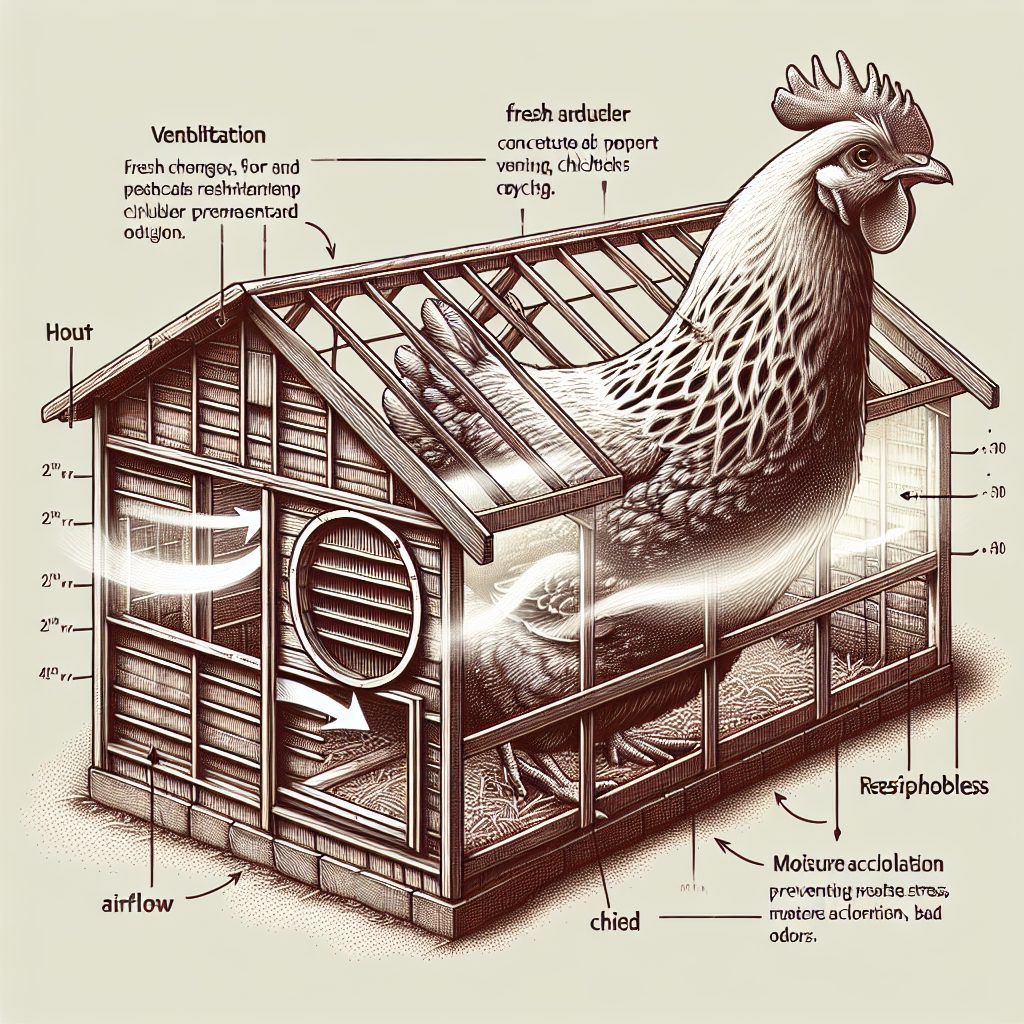If you’re a chicken owner concerned about the health and well-being of your feathery friends, you’ve probably wondered how you can make sure they’re getting enough exercise. Providing adequate exercise for your chickens is essential for their overall health maintenance. But fear not, because in this article, we will explore some simple yet effective ways to ensure that your chickens are staying active and getting the exercise they need to thrive. So let’s dive in and discover how you can keep your chickens fit, happy, and healthy!
Creating a Spacious Environment
Provide a Large Coop
When it comes to creating a spacious environment for your chickens, providing a large coop is essential. Chickens need plenty of room to move around, stretch their wings, and engage in natural behaviors. A spacious coop not only allows for better ventilation and reduced stress levels but also promotes better overall health.
Include a Chicken Run
In addition to a large coop, it is important to include a chicken run in your setup. A chicken run is an outdoor enclosure that provides chickens with a safe and secure space to roam and explore. This allows them to experience the outdoors, peck at the ground, and soak up the sun’s rays. A chicken run gives your flock the opportunity to engage in natural behaviors while still being protected from predators.
Ensure Sufficient Roaming Area
Alongside a large coop and chicken run, it is crucial to provide your chickens with sufficient roaming area. Chickens are naturally curious and love to explore their surroundings. By giving them a designated space to roam, you are allowing them to exercise their muscles, stretch their legs, and engage in mental stimulation. A spacious roaming area also helps prevent overcrowding, which can lead to aggression and stress among the flock.
Installing Chicken-Friendly Equipment
Implement Perches and Platforms
One way to encourage exercise and physical activity in chickens is by implementing perches and platforms within their coop. Chickens naturally enjoy perching at different heights, and providing them with perches and platforms not only gives them a change of scenery but also encourages them to hop, jump, and balance. This helps to develop their leg muscles and keeps them active and engaged.
Install Swings or Ladders
Another chicken-friendly equipment that promotes exercise and entertainment is the installation of swings or ladders. Swings provide a fun way for chickens to exercise by swinging back and forth, while ladders allow them to climb and descend, strengthening their leg muscles. These additions not only add variety to their environment but also stimulate their natural curiosity and promote physical activity.
Place Dust Baths
Chickens love to take dust baths, and providing them with a designated area for this activity not only satisfies their natural instincts but also encourages exercise. Dust baths help keep chickens clean by removing excess oils and mites from their feathers. By ensuring there is a proper area for them to engage in this behavior, you are effectively promoting exercise and maintaining the overall health of your flock.
Encouraging Natural Foraging Behaviors
Use Scattering or Hiding Feeding Techniques
One way to ensure that your chickens are getting adequate exercise is by using scattering or hiding feeding techniques. Instead of simply placing their food in a bowl or trough, scatter the feed around their roaming area or hide small amounts of food in various places. This encourages chickens to actively search for their food, mimicking their natural foraging behaviors. This not only provides mental stimulation but also encourages physical activity as they move around, pecking and scratching to find their sustenance.
Provide Access to Outdoor Vegetation
Incorporating outdoor vegetation into your chickens’ environment can have a significant impact on their exercise levels. Chickens are natural foragers and love to peck and scratch the ground in search of insects, worms, and plants. By allowing them access to outdoor vegetation, such as grassy areas or garden beds, they will have the opportunity to engage in these natural foraging behaviors. This not only keeps them physically active but also provides them with a diverse and balanced diet.
Introduce Treat Dispensing Toys
To make exercise more enjoyable for your chickens, consider introducing treat dispensing toys. These toys are specifically designed to hold treats inside, requiring chickens to peck, roll, or manipulate the toy to access the treats. By doing so, chickens engage in physical activity while also being rewarded with treats. This promotes both mental and physical stimulation, keeping them active and entertained.
Promoting Social Interactions
Keep Multiple Chickens
Chickens are social animals, and keeping multiple chickens is essential for their overall well-being. By having a flock of chickens, you are promoting social interactions among them. Chickens naturally engage in activities such as preening, dust bathing, and foraging together, creating a sense of companionship and reducing stress. Social interactions not only contribute to their mental health but also encourage physical activity as they play and interact with each other.
Allow Interaction with Other Animals
In addition to keeping multiple chickens, allowing interaction with other animals can greatly benefit their exercise levels. Chickens are known to coexist well with other animals, such as ducks or goats, and by providing opportunities for them to interact, you create a dynamic and stimulating environment. For example, allowing chickens to free-range in a larger space alongside other animals encourages them to explore, play, and engage in physical activities such as chasing or pecking at insects together.
Arrange Regular Playtime
To promote social interactions and exercise among your chickens, arranging regular playtime is an excellent idea. Set aside dedicated time each day to interact with your chickens by playing games, providing treats, or simply spending time observing and engaging with them. This not only deepens the bond between you and your chickens but also encourages physical activity as they follow and play with you. Regular playtime ensures that your chickens are getting the exercise they need while also experiencing social interactions.
Training and Conditioning Exercises
Teach Simple Tricks or Commands
Training your chickens to perform simple tricks or commands is not only fun but also a great way to encourage exercise. Chickens are intelligent animals and can learn to respond to cues and commands. You can train them to jump on platforms, walk through tunnels, or even turn in circles. These training sessions provide mental stimulation and physical activity, keeping your chickens engaged and active.
Practice Obstacle Courses
Setting up obstacle courses for your chickens to navigate is another effective way to provide exercise and mental stimulation. Obstacle courses can be as simple as placing small wooden hurdles or tunnels that chickens have to navigate around or through. By introducing these challenges, you encourage them to think, problem-solve, and physically maneuver their bodies, promoting overall health.
Engage in Reward-Based Training
When training and conditioning your chickens, it is important to use positive reinforcement methods. Reward-based training involves providing treats or praise when chickens successfully complete a task or obey a command. By associating exercise and training with rewards, chickens are motivated to engage in physical activity and learn new skills. This approach creates a positive and enjoyable experience for both you and your chickens.
Ensuring Regular Free Ranging
Allow Free-Range Time
To ensure that your chickens are getting adequate exercise, it is crucial to allow them regular free-range time. Free-ranging simply means allowing your chickens to roam and explore a larger area outside of their coop and run. This gives them the opportunity to engage in natural behaviors such as foraging, scratching the ground, and exploring their surroundings. Free-ranging not only provides physical exercise but also exposes them to natural sunlight, fresh air, and a diverse range of sights, smells, and sounds.
Supervise and Protect
While free-ranging is important for exercise, it is essential to supervise and protect your chickens during this time. Predators, such as hawks, foxes, or dogs, pose a threat to your flock, and keeping a close eye on them prevents potential harm. Supervision also allows you to intervene and redirect any unwanted behaviors, ensuring the safety and well-being of your chickens. Additionally, make sure that your chickens are protected from escaping or wandering into dangerous areas.
Secure the Premises
To safely allow your chickens to free-range, it is necessary to secure the premises. This includes having a well-maintained fence or enclosure that prevents predators from entering and chickens from escaping. Ensure that there are no holes or gaps in the fence and that any potential entry points, such as gaps under gates or fences, are sealed. Providing a safe and secure environment for your free-ranging chickens not only allows for exercise but also brings peace of mind.
Implementing Enrichment Activities
Provide Toys and Puzzles
Enrichment activities are essential for keeping your chickens mentally stimulated and engaged. Providing toys and puzzles is an effective way to achieve this. Toys such as hanging mirrors or pecking balls not only engage chickens physically but also provide mental stimulation as they peck, play, and investigate their surroundings. Puzzles, such as treat-dispensing toys or mazes, encourage problem-solving and critical thinking, making exercise a fun and rewarding experience.
Hang Treat-Filled Pinatas
Another exciting enrichment activity for chickens is hanging treat-filled pinatas. These pinatas can be made from materials such as paper, cardboard, or cloth and filled with treats or fruits. By hanging them at different heights, chickens are encouraged to jump, peck, and tear at the pinata to access the treats. This playful activity combines exercise with mental stimulation, providing a fun and interactive experience for your chickens.
Offer Environmental Variety
To keep your chickens active and engaged, offer them a variety of environmental stimuli. This can include introducing different textures on the ground, such as straw, hay, or wood chips, as well as placing natural objects like logs or branches for them to explore and perch on. Creating an environment that is rich in diversity helps stimulate their senses and encourages physical activity as they interact with their surroundings.
Monitoring and Tracking Activity Levels
Use Activity Trackers
Monitoring and tracking your chickens’ activity levels can provide valuable insights into their overall health and exercise routines. Activity trackers specifically designed for chickens can be attached to their legs or wings and provide data on their movement, steps taken, and overall activity levels. By regularly checking and analyzing this information, you can ensure that your chickens are getting sufficient exercise and make any necessary adjustments to their environment or routine.
Observe Behavioral Cues
In addition to using activity trackers, closely observing your chickens’ behavior can also give you an indication of their exercise levels. Active and energetic chickens are more likely to be getting sufficient exercise, while lethargic or sedentary behavior may suggest that they need more physical activity. By paying attention to their behavior and body language, you can gauge whether any adjustments or interventions are needed to promote exercise.
Maintain Health and Weight Records
Keeping track of your chickens’ health and weight is an important aspect of ensuring they are getting adequate exercise. Regularly weighing your chickens and recording their weights allows you to monitor any fluctuations or concerns. Additionally, maintaining health records and noting any changes in behavior or appetite helps identify potential health issues that may affect their exercise capabilities. By keeping accurate records, you can address any concerns promptly and ensure the well-being of your flock.
Seeking Professional Assistance
Consult an Avian Veterinarian
If you have concerns about your chickens’ exercise routine or overall health, consulting an avian veterinarian is highly recommended. Avian veterinarians specialize in the health and well-being of birds, including chickens, and can provide valuable guidance and advice. They can assess your chickens’ needs, conduct health checks, and recommend appropriate exercise strategies or interventions if necessary. Seeking professional assistance ensures that your chickens receive the best care and exercise for optimal health.
Hire a Poultry Trainer
For those who want to take their chickens’ exercise routine to the next level, hiring a poultry trainer can be a great option. Poultry trainers specialize in working with chickens and can help design personalized exercise programs tailored to your flock’s needs. They can introduce advanced training techniques, teach complex tricks or commands, and provide ongoing support and guidance. Hiring a poultry trainer ensures that your chickens receive expert guidance and motivation to stay active.
Attend Workshops or Seminars
Participating in workshops or seminars focused on chicken care and exercise can provide valuable insights and knowledge. These events often feature experts in poultry care who share their expertise and techniques. Attending such events allows you to learn from experienced individuals, gain new ideas, and connect with other chicken owners. Workshops and seminars provide a valuable educational experience and can inspire you to enhance your chickens’ exercise routines.
Final Thoughts
Understanding Your Chickens’ Needs
In conclusion, understanding your chickens’ needs is key to ensuring they receive adequate exercise for health maintenance. Chickens are active animals that thrive when they have sufficient space to move around, engage in natural behaviors, and interact socially. By creating a spacious environment, installing chicken-friendly equipment, and encouraging natural foraging behaviors, you can provide ample opportunities for exercise.
Adapting to Individual Differences
It is important to recognize that each chicken is unique and may have different exercise requirements. Paying attention to their individual differences, preferences, and capabilities allows you to tailor their exercise routines accordingly. Some chickens may be more active and adventurous, while others may be more laid-back or less physically inclined. Adapting to these differences ensures that each chicken receives appropriate exercise levels and remains healthy.
Prioritizing Exercise for Overall Health
Making exercise a priority for your chickens is essential for their overall health and well-being. Regular exercise promotes physical fitness, mental stimulation, and social interactions, while also preventing obesity, muscle atrophy, and boredom-related behaviors. By incorporating various exercise strategies, monitoring activity levels, and seeking professional assistance when needed, you can ensure that your chickens lead a happy and active lifestyle.




